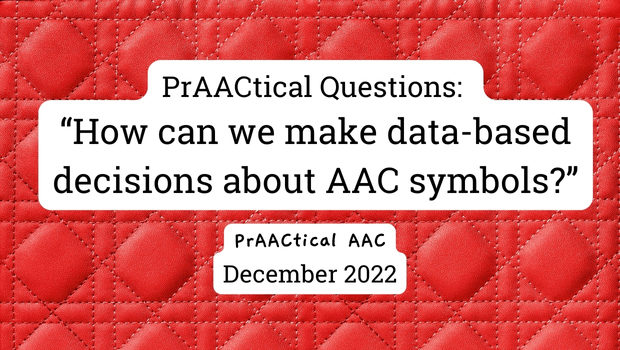PrAACtical Questions: “How can we make data-based decisions about AAC symbols?”

Data isn’t the only thing we use in AAC decision-making, but it’s a good-sized slice of the pie. Those using the feature match approach to AAC device/app selection, a gold standard for several decades, use direct assessment procedures to guide the selection of AAC devices and apps based on the features they contain. The symbol set(s) or systems(s) available in each AAC tool is one of the features that we consider.
In this post, we share some of the assessment tasks that can be used to gain insight into how individuals do with different types of AAC symbols. In each one, the task is repeated with a specific type of symbol, so that we can make an apples-to-apples comparison. This part of the assessment is time-consuming and generally done over multiple sessions. These are drawn from the work of the later Dr. David Beukelman, and his co-authors, Dr. Pat Mirenda and Dr. Janice Light.
AAC Symbol Assessment Tasks
In each of these tasks, professionals:
- Use language concepts that the potential AAC user understands;
- Represent words and objects using multiple types of AAC symbols;
- Carefully select the response options; and,
- Teach symbol meanings.
They then assess the person’s understanding and use of the symbols using one or more of these informal assessment tasks.
Receptive Task 1: Labeling Format
Basic process: Using two or more symbols, present an array of response options. Instruct the learner to point to, touch, give, or otherwise indicate one of them in their response to a directive (e.g., “point to sock,” “touch walk,” “give me heavy”). The location of the correct response is varied in each trial.
Receptive Task 2: Yes/No Format
Basic process: When individuals have vision or motor difficulties that make the Receptive Labeling format difficult, an alternative format is used. In this task, familiar language concepts are again represented through one or more symbols. As each one is held up, the learner is asked to confirm or refute its label (e.g., “Is this ___?”). This is only used with individuals who have a clear yes/no response, and the order of questions is arranged randomly with no clear pattern of correct responses.
Receptive Task 3: Visual Matching Format
Basic process: When potential AAC users either don’t understand the spoken labels or the task directions, symbol assessment relies on their matching skills. They are presented with an array of two or more symbols and shown an object. They are instructed to match one of the symbols to the object using a preferred response modality (e.g., pointing, touching, giving, eye pointing).
Expressive Task 1: Functional Requesting Format
Basic process: Generally conducted in an appropriate natural context, this task allows us to look at how the potential AAC learner uses symbols to ask for things they want or need. They are then given an array of options with two or more symbols and the person makes a request by selecting one of them using their preferred modality (e.g., eye gaze, pointing). If no selection is made, they are asked “What do you want?”
Expressive Task 2: Functional Question-Answer Format
Basic process: This task goes beyond requesting to assess expressive abilities in more social contexts. They are again given an array of two or more symbols and then asked meaningful questions (e.g., “What is your favorite holiday?” “What sport do you like best?”). Potential AAC learners use their preferred modality to respond.
Interpreting Results
Each of these tasks yields quantitative information (e.g., 4/5 correct, 100% accurate). The task is then repeated at least once with a different kind of symbol. For example, if the options were presented with PCS the first time, we might assess them using SymbolStix the next time, and then finally with Minspeak/Unity symbols.
This is what allows the team to make data-based decisions. They can compare the results of the same task across the different symbol types that were used. Whether the results are clearly better for one type of symbol over the other, or if performance is the same regardless of what type of symbol was presented, this yields important information for the team. While there are other approaches to making these decisions, teams should at least consider the utility of this kind of data.
You can find earlier posts in this series here.
- “How important is symbol selection in choosing AAC devices/apps?” and,
- “What symbols are used in AAC apps & SGDs?”
In the next post in this series, we address this prAACtical question: “What factors should we consider in choosing the symbol type for AAC?”
REFERENCES
Note: This post summarizes the basic procedures for each task. Prior to utilizing these for decision-making, readers are encouraged to learn more through the following books.
Beukelman, D.R., & Light, J.. (2020). Augmentative and Alternative Communication: Supporting Children and Adults with Complex Communication Needs, 5th Edition. Baltimore, MD: Paul H. Brookes Publishing Company.
Beukelman, D.R., & Mirenda, P. (2013). Augmentative and Alternative Communication: Supporting Children and Adults with Complex Communication Needs, 4th Edition. Baltimore, MD: Paul H. Brookes Publishing Company.
Filed under: Featured Posts, PrAACtical Thinking
This post was written by Carole Zangari

1 Comment
I know this is an old post so may not be monitored, but how do you make these decisions with kids in Early Intervention? Do you just move forward with whichever app is first introduced? What about kids with ASD who typically have receptive language higher than they are able to show in standard testing due to noncompliance when asked to id items?